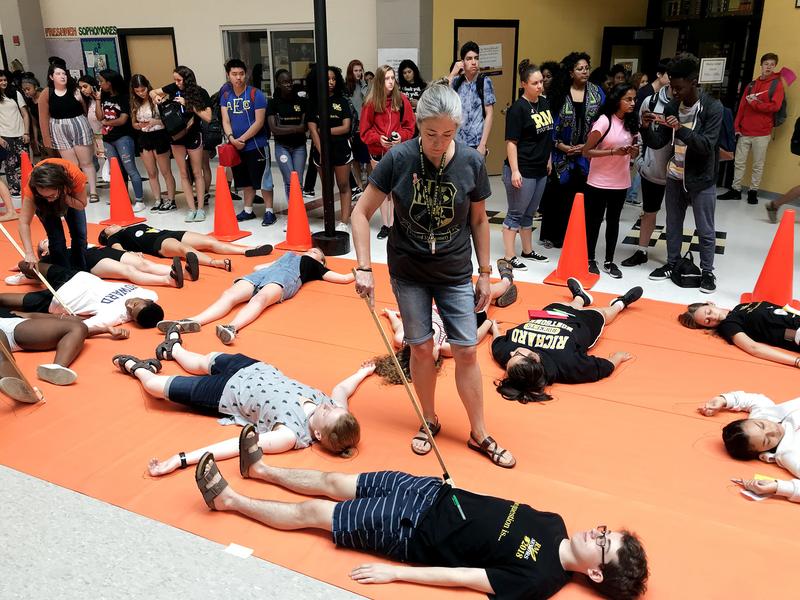 All Things Considered
All Things Considered
As Graduates In Santa Fe And Parkland Look Ahead, A Look Back On Activism This Year

High school seniors who survived the deadly shooting in Santa Fe, Texas, just two weeks ago, graduated Friday.
On Sunday, the 2018 class at a Parkland, Fla. high school, where a gunman killed 17 people, will also receive their diplomas.
It was in the days after that Valentine's Day shooting at Marjory Stoneman Douglas High School that survivors-turned-advocates became a national force in calling for tighter gun regulation in the U.S.
And for students, it's also been a lesson in patience.
Just five weeks after that school shooting, students from Parkland — along with a coalition of supporters across the nation — attracted hundreds of thousands to a national rally on March 24 — "The March For our Lives" — to call for stricter gun laws and school safety.
But getting federal lawmakers to pass broad gun reforms is another matter entirely.
Just last week, a pair of Parkland students were on Capitol Hill speaking to the Gun Violence Prevention Task Force — an all-Democrat panel.
There, high school junior Alfonso Calderon pressed lawmakers on why little has been done about gun violence since 17 people were killed at his school.
"There's been a lot of talk about putting America first," Calderon said during his opening remarks. "I agree, let's put America first and put the gun lobbies and the NRA second. I don't understand why this is such a difficult conversation to have."
Calderon's classmate, Charlie Mirsky, also a junior, has been to Washington D.C., five times since the shooting at his school.
While Mirsky is disappointed that changes to national gun laws have not come swiftly, he is confident student-led action is slowly swaying lawmakers.
"I mean, I've been frustrated long before anything happened. I was just a professional complainer before being a professional activist," Mirsky said. "And although we were frustrated with the way things are, we actually feel like we can do something now."
That something means keeping pressure on Congress.
Federal lawmakers passed modest gun measures included in the $1.3 trillion omnibus legislation that President Trump signed into law in March. But it fell well short of what gun control advocates were pushing for, including bans on assault weapons and universal background checks.
A handful of states and local governments have taken action on guns.
Washington state passed a law banning bump stocks, the devices attached to semiautomatic weapons that cause them to fire like a machine gun. Florida tightened gun restrictions in the state by raising the legal age to purchase firearms to 21 and instituted a three-day waiting period for gun purchases. Vermont passed a series of laws, including limiting handgun and rifle magazines to 15 and 10 rounds, respectively.
And using social media, young people kept the momentum going throughout the spring — organizing not one, but two national school walkouts, where students left their classrooms to protest gun violence in schools.
Then it happened again.
Eight students and two teachers were gunned down in Santa Fe, Texas, about 40 miles southeast of Houston by a 17-year-old student last month.
After that, young people took to social media again, using hashtags like #IfIDieInASchoolShooting.
Much like some students from Parkland, there are surviving students from Santa Fe who are turning their experience into something more positive. Bree Butler, on the day of her graduation, told NPR's Mary Louise Kelly that she and her friends have started a nonprofit called the Orange Generation.
"Our goal is to help fund survivors' medical bills, their physical therapy, their PTSD counseling, their surgeries. Things like that," Butler said.
Butler also said that the nonprofit would support candidates who are pro-gun reform. "We'll see where all that goes. It's all still, you know, in the very, very, very beginning stages."
If walkouts were the theme of the spring, summer brings with it the promise of protests called die-ins. At Richard Montgomery High School in Rockville, Md., last week, 43 students took turns lying on an orange tarp as if they had been shot.
Faculty members traced their body outlines with markers.
Daniel Gelillo, a senior and one of the organizers of the event, said he has been "entrenched" in the gun debate ever since the Parkland shooting.
"I don't think there would have been any other way that I would have spent my last day of high school other than pushing to make sure schools will be safe, even after I'm done with public school."
He said even when he's gone, his friends and sister will be at the school next year. "I don't want them to have to go to school in fear and in danger of being killed by someone just because they had easy access to a gun."
David Hogg, one of the lead student activists from Parkland, staged a similar die-in demonstration at Publix grocery stores in Florida last week over the supermarket chain's financial support of a pro-gun candidate running for governor.
Soon after the die-in, the chain announced it was suspending all corporate contributions.
A National Die-In Day is scheduled later this month, to coincide with the second anniversary of the Pulse nightclub shooting in Orlando in 2016 where 49 people died.
Other ideas are being floated for the coming school year, including one calling for a national school boycott, championed by former Education Secretary Arne Duncan. In that protest, parents would pull kids out of class until new federal gun laws are passed.
It's not clear how much traction that idea is getting.
The more pressing question, though, is whether these small successes will lead to a big victory for these gun-control activists before the November midterm elections.
9(MDEwODYxNTQyMDEzNjAxODk2Nzc2NzNmYQ001))